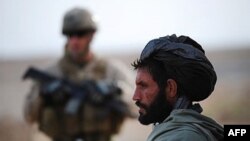The current administration, under the leadership of President Obama and U.S. Secretary of State Hillary Clinton, elevated the roles of diplomacy and development to equal that of defense in the implementation of U.S. foreign policy.
For example, in Afghanistan, as Afghan military units, with the support of ISAF forces, reclaimed territory from militants in Operation Moshtarak, which recently took place in Marjah, Helmand Province, civilian aid and development specialists moved with them. These specialists, who comprised the District Stabilization Team, are working with Afghan government officials at the district level to expand the reach of the government and its ability to provide basic services, such as rule of law; medical clinics and schools; roads linking villages to district centers; power stations and irrigation systems.
Dr. Rajiv Shah, director of the U.S. Agency for International Development recently returned from a trip to Afghanistan, including a visit to the Arghandab DST in Kandahar Province. "I saw a strong civilian and military cooperation. . . . a combined effort of providing agricultural vouchers to local farmers working to improve the irrigation system in that area, helping to improve some of the road infrastructure. Those things have really made a difference," he said during a press conference following his trip.
Dr. Shah also praised the Afghan First policy, a top priority of the Obama administration. "It’s an effort to procure services locally and to build local Afghan institutions as we implement the assistance package," said Dr. Shah:
"Inside of a year, our USAID-related assistance has gone from hiring three thousand Afghan employees in full-time jobs to hiring more than twenty six thousand.
"A big part of that increase is a transition to larger infrastructure investments, which are more employment-rich in their execution. But nevertheless, it’s an important transition, I think one that is recognized and appreciated by the Afghan people and their institutions."
That's not to say everything is moving without a hitch in Afghanistan. In recent weeks, Taliban extremists have been brutally victimizing innocent civilian aid workers in their misguided effort to disrupt development work – the very projects that aim to improve the lives and livelihoods of the Afghan people.
Thanks to the dedicated and brave civilian aid workers and officials, both Afghan and international, progress, however, is unstoppable. Work continues on development projects. New pomegranate orchards are flourishing. And in Herat, hundreds of marble producers, processors, business representatives, international investors, and government officials recently launched the second annual Afghanistan International Marble Conference, showcasing one of Afghanistan’s most valuable resources, and creating critical private-sector linkages.
"When we work together, things can work," said Dr. Shah. "And it does leave people hopeful for a brighter future."
Progress Continues In Afghanistan

As Afghan military units, with the support of ISAF forces, reclaim territory from militants, civilian aid and development specialists move with them.















